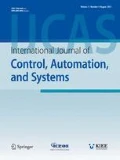Abstract
Building block hypothesis suggests that the highly-fit low-order schemata recombine with each other to form even more highly-fit high-order ones. One may naturally surmise that the coding should be designed to supply adequate superior order-1 schemata. In this paper, it is showed that, if superior order-1 building blocks are provided at most of the loci, there is likely to be remarkable fitness differences among high-order schemata, which indicates the existence of ‘pulse-shaped’ peaks on the curve of the fitness function. And fitness differences among the individuals are so great within the neighborhoods of these peaks that diversity loss tends to occur when searching within these regions. The results of this paper may to some degree explain why additional measures to maintain diversity should be taken to improve the local search performance of a simple genetic algorithm (GA).
Similar content being viewed by others
References
J. H. Holland, Adaptation in Natural and Artificial systems, University of Michigan Press, Ann Arbor, MI, 1975.
D. E. Goldberg, Genetic Algorithms in Search, Optimization and Machine Learning, Addison Wesley, Reading, MA, 1989.
D. Whitley, R. B. Heckendorn, and S. Stevens, “Hyperplane ranking, nonlinearity and the simple genetic algorithm,” Information Sciences, vol. 156, no. 15, pp. 123–145, November 2003.
D. Whitley, “An overview of evolutionary algorithms: practical issues and common pitfalls,” Information and Software Technology, vol. 43, no. 14, pp. 817–831, December 2001.
S. Forrest and M. Mitchell, “Relative building-block fitness and the building-block hypothesis,” in Foundations of Genetic Algorithms 2, eds. D. Whitley, pp. 109–126, 1993.
A. S. Wu and K. S. DeJong, “An examination of building block dynamics in different representations,” Proc. of the Congress on Evolutionary Computation, pp. 6–9, 1999.
D. E. Goldberg, “Construction of high-order deceptive functions using low-order Walsh coefficients,” Annals of Mathematics and Artificial Intelligence, vol. 5, no. 1, pp. 35–48, March 1992.
K. Deb, J. Horn, and D. E. Goldberg, “Multimodal deceptive functions,” Complex Systems, vol. 7, no. 2, pp. 131–153, 1993.
K. Deb and D. E. Goldberg, “Sufficient conditions for deceptive and easy binary functions,” Annals of Mathematics and Artificial Intelligence, vol. 10, no. 4, pp. 385–408, December 1994.
T. Kuo and S. Y. Hwang, “Genetic algorithm with disruptive selection,” IEEE Trans. Systems, Man, and Cybernetics, Part B, vol. 26, no. 2, pp. 299–307, April 1996.
C. van Hoyweghen, D. E. Goldberg, and B. Naudts, “Building block superiority, multimodality and synchronization problems,” Proc. of the Genetic and Evolutionary Computation Conference, pp. 694–701, 2001.
D. E. Goldberg, K. Sastry, and T. Latoza, “On the supply of building blocks,” Proc. of the Genetic and Evolutionary Computation Conference, pp. 336–342, 2001.
Author information
Authors and Affiliations
Corresponding author
Additional information
Recommended by Editorial Board member Sungshin Kim under the direction of Editor Young Il Lee. This work was supported by SRF for ROCS, SEM, China, and BK21, Korea.
Hongqiang Mo received the B.E. and Ph.D. degrees in Automatic Control Engineering from South China University of Technology in 1996, and 2001, respectively. His research interests include evolutionary computation, process control, and process signal processing.
Zhong Li received the B.Sc., M.Sc., and Ph.D. degrees from Sichuan University, Jinan University, and South China University of Technology, in 1989, 1996, and 2000, respectively. He obtained his Dr. of Science (Habilitation) from FernUniversität in Hagen in 2007. His research interest includes fuzzy logic and fuzzy control, chaos theory and chaos control, intelligent computation and control, complex networks, swarm intelligence.
Jin Bae Park received the B.E. degree in Electrical Engineering from Yonsei University, Seoul, Korea, and the M.S. and Ph.D. degrees in Electrical Engineering from Kansas State University, Manhattan, in 1977, 1985, and 1990, respectively. Since 1992, he has been with the Department of Electrical and Electronic Engineering, Yonsei University, Seoul, Korea, where he is currently a professor. His research interests include robust control and filtering, nonlinear control, mobile robot, fuzzy logic control, neural networks, genetic algorithms, and Hadamard transform spectroscopy. He serves as the Vice-President for the Institute of Control, Robot, and Systems Engineers (ICROS) (2009–2010) and Editor-in-Chief for the International Journal of Control, Automation, and Systems (IJCAS) (2006–2010).
Young Hoon Joo received the B.S., M.S., and Ph.D. degrees in Electrical Engineering from Yonsei University, Seoul, Korea, in 1982, 1984, and 1995, respectively. He worked with Samsung Electronics Company, Seoul, Korea, from 1986 to 1995, as a project manager. He was with the University of Houston, Houston, TX, from 1998 to 1999, as a visiting professor in the Department of Electrical and Computer Engineering. He is currently a professor in the School of Electronic and Information Engineering, Kunsan National University, Korea. His major interest is mainly in the field of intelligent robot, intelligent control, human-robot interaction(HRI), and nonlinear systems control. He is serving as President for Korea Institute of Intelligent Systems (KIIS) (2008–2009) and Editor for the Internatioal Journal of Control, Automation, and Systems (IJCAS) (2008–2010).
Xiangyang Li received the Ph.D. degree in Automatic Control Engineering from South China University of Technology in 2001. His research interests include machine learning, embedded systems and wireless sensor networks.
Rights and permissions
About this article
Cite this article
Mo, H., Li, Z., Park, J.B. et al. Fitness landscape for simple genetic algorithms supplied with adequate superior order-1 building blocks. Int. J. Control Autom. Syst. 8, 135–140 (2010). https://doi.org/10.1007/s12555-010-0117-8
Received:
Accepted:
Published:
Issue Date:
DOI: https://doi.org/10.1007/s12555-010-0117-8




